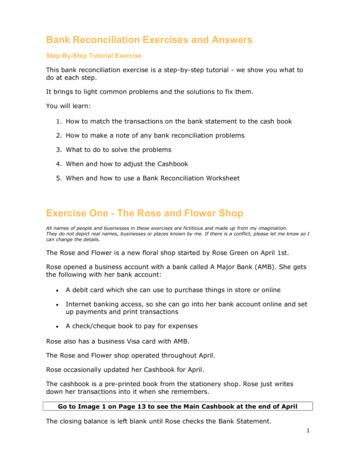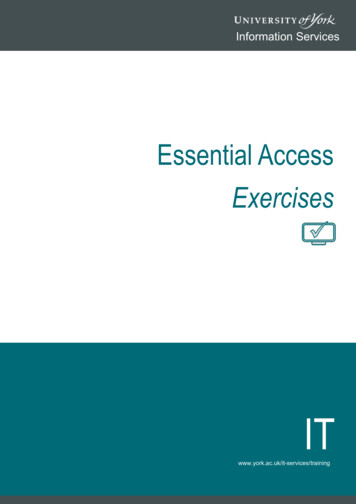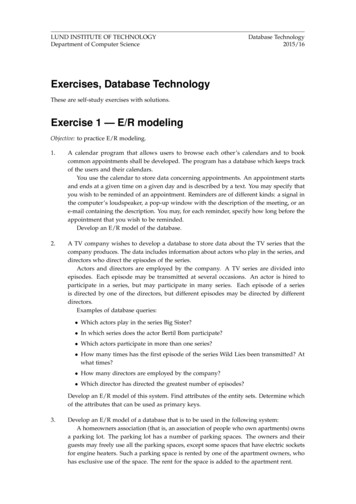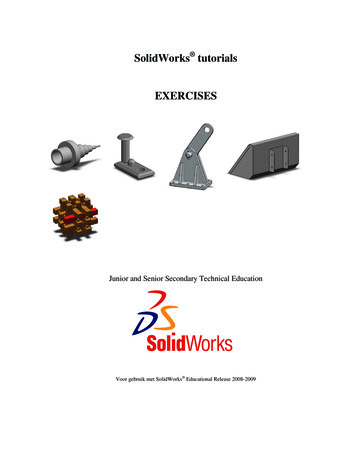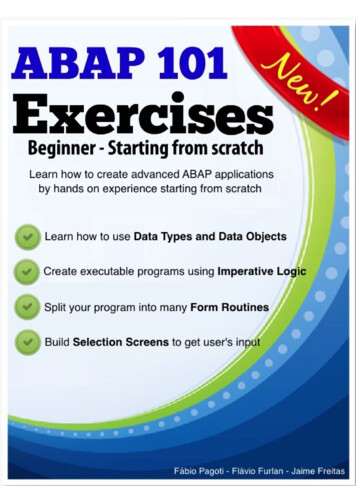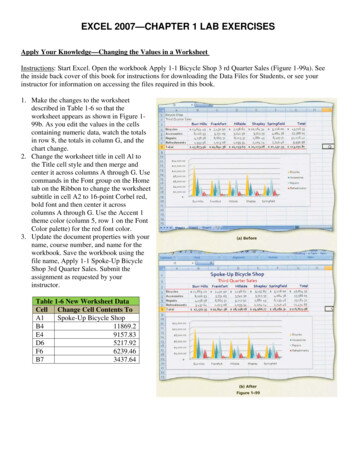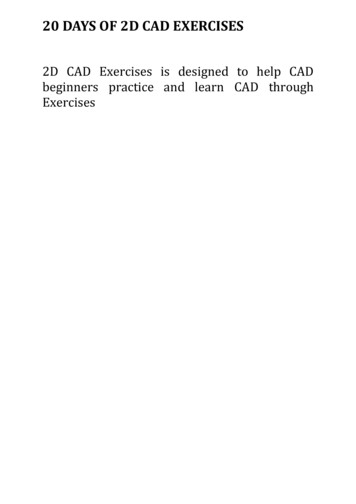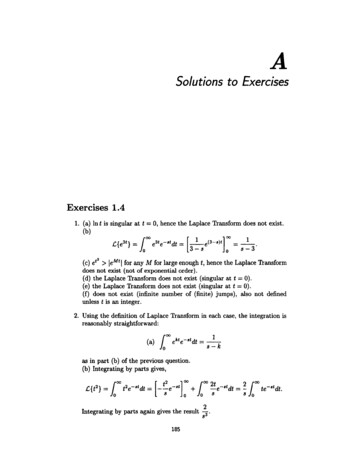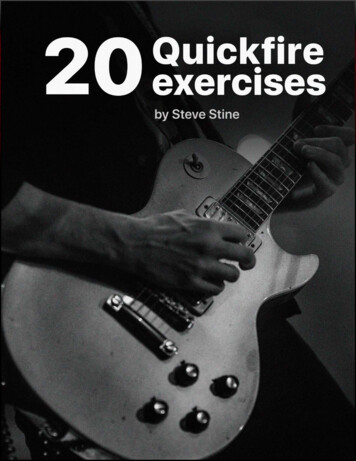
Transcription
byGuitarZoom 2012Denley20QuickfireExercises1
20QuickfireExercisesby Steve StineTable of Contents! Click on Title to jump to pageIntro3What you can expect3A great side benefit3I admit it4Practical ways to use this book4About the notation4“Are you nuts?” 5Your old friend, Mr. Metronome5How to quickly and easily make massive progress5A word of caution6How far should you go?6Ready, steady, go!7Zoom! Zoom!7Time to play!7Exercise 18Exercise 29Exercise 310Exercise 411Exercise 512Exercise 613Exercise 714Exercise 815Exercise 916Exercise 1017Exercise 1118Exercise 1219Exercise 1320Exercise 1421Exercise 1522Exercise 1623Exercise 1724Exercise 1825Exercise 1926Exercise 2027Final thoughts282Play Songs By Your Favorite Bands
by Steve Stine20QuickfireExercisesIntroMany guitarists have trouble fretting difficult chords, playing certain scales and reaching big intervals. Thisbook sets out to solve these problems and more.One of the biggest problems I see routinely with guitarists (especially those who played for less than ayear) is finger strength.It’s actually not taught much anymore (or maybe I’m just not aware of it). And I don’t understand why.I almost never hear of instructors giving practice assignments that are specific for building finger strength,dexterity and agility.Think about it. If you’re a professional football player how much time do you spend off the field trainingyour body? You run, lift weights, swim, ride a bike, stretch, etc., all to train your body. Now imagine if a playerdecided he wasn’t going to work out. He just wants to show up at game time and play. He’d get slaughtered.He wouldn’t last 15 minutes on the field with the guys who worked hard to get in shape.It’s the same thing with guitar. Your hands and forearms are made up of a bunch of muscles, bones andconnective tissue. And you’ve got to train them to do what you tell them to do.There is an inherent disconnect between what your brain wants to play and what your muscles are capableof playing. In order to bring your brain and your muscles together in perfect harmony, you’ve got to put ina little work.What You Can ExpectHere’s the deal. If you will commit yourself to practicing one of these twenty exercises for 5 minutes a day,for twenty straight days, you’ll be able to rip a four-inch, yellow pages into two pieces with your bare hands!Well. ok, ok. Maybe you won’t be able to do that, exactly. But I will say this. You will be shocked at howmuch faster and stronger your hands and fingers get. And not just playing these exercises. You’ll have morecontrol, in general: more control over your songs, solos and riffs. You will essentially be a much better player.A Great Side BenefitWhat’s amazing about these exercises is that they have a double effect: one on your left hand, and oneon your right. In other words, not only will your left hand (if that’s the one your use to fret with) be muchstronger, but your right hand will be much more accurate! Why? Well, think about it.Learn Songs Featuring These Exercises3
20QuickfireExercisesby Steve StineAll these exercises involve your right and left hand. So as your practicing them you’ll not only get a muchstronger and more agile left hand, you’ll also be able to pick with greater speed and accuracy.I AdmitOk, I’m going to go ahead and admit it, right on the front end. Playing these exercises isn’t that fun. Ok,dang it. They’re pretty stinking boring. There, I said it. But you know what, Brett Favre probably didn’t thinkrunning three miles every day was much fun either. But I assure you, he definitely thought winning theSuper Bowl was fun. But without his dedication to training, he wouldn’t have been able to win the big game.You’ve got to think of these 20 exercises as guitar, boot-camp for your fingers. They are the training yourfingers need in order to play in the “big game.”In other words, if you want to play the solo guitar part in “Free Bird” (Lynard Skynard) you better get inshape. Why? Well, because that song is long. I think it’s something like ten minutes. And it has a lot ofhammer-on’s and pull-off’s. It takes a lot of strength, agility and speed.Or maybe you just want to play in a three-chord, rock band. You still need to have massive finger strength.Why? Because I used to play in a three-chord, rock band. And even if you’re only playing three chords, afteryou rehearse for two hours, you’re going to be tired if you’re not in shape. And you know when you get tired:you can’t fret your guitar, you’re not able to hold down the strings, your fingers slip, your forearm burns andyour back aches.The point I’m driving at is this: no matter what your goals are for guitar, having super-strong hand andfingers is going to be a huge asset. It just can’t hurt.Practical ways to use this bookOk, now that we’ve gotten the philosophical “Why?” questions out of the way, let’s talk about real-world,practical, down-to-earth ways to use this book.About the notationI’ve written twenty exercises for you. They are all here for your enjoyment. I’ve given you both thestandard notation and the tablature for each exercise. This will help you start to memorize the notes on thefretboard. Try to ask yourself as you practice, “What note am I playing?” Then relate the note on the staff tothe string you are fretting.4Have More Fun With Your Guitar
by Steve Stine20QuickfireExercisesMost of the symbols you will be familiar with. A few you may not be. For those symbols that might be outof the ordinary, I’ve created a few notes next to the diagram to explain.“Are you nuts?”If someone walks in the room while you’re playing these, she’ll probably look at you as if you have threeeyes. The immediate thought might be, “OK, he’s completely lost it.” But never fear. I assure you. You’re notnuts. You’re practicing. And that’s going to make you that much better when it does come time to play yourfavorite songs.One nice thing about these exercises is that they are atonal. In other words, they aren’t based the diatonicscales, modes or pentatonic scales. They’re just exercises. So they aren’t supposed to be sweet to your ears.And you do not want to play these for your sweetheart on the first date.Your old friend, Mr. MetronomeIf you do not have a metronome, you need to invest in one. You can get them at practically any music store,on or offline. If you’re looking for a recommendation on where to get gear at reasonable prices, you canalways go here:Ready to see how these exercises help you play songs better?Anyway, here’s why I like to practice these with a metronome. You get to watch yourself improve day-by-day.How? Well, when you’re first starting out, you want to pick a relatively slow speed: say, 60 beats per minute60 BPM and play the first exercise. Now, tomorrow you’ll want to try to increase it to 75BPM, the next day,go to 90, etc. You get the idea.And it’s a good idea to keep a journal of your practice. Write down what you practiced and for how long. Forexample, you might record that you practiced exercise one for five minutes at 60 BPM. Then a week lateryou might notice that you’ve increased that same exercise to 120 BPM! That kind of feedback is good foryou. You should definitely make the effort to keep a journal, or practice log. When you look back a year fromnow, you’ll be amazed at how much better you’ve gotten, in such a short amount of time.How to quickly and easily make massive progressThere are a total of twenty exercises in this book. Each one gets a little more difficult. By the time you getto the twentieth one, you’ll be doing some pretty advanced stuff. But it’s kind of like math. You can’t multiplyEnjoying these exercises? Here’s what to do next5
20QuickfireExercisesby Steve Stineuntil you can add. And you can’t bypass the first nineteen exercises and jump to number twenty. That won’twork. You need to go in order.What I suggest is that you practice number one for five minutes, at a given BPM. Tomorrow, you practicenumber two for five minutes. The next day, number three for five minutes and so-on and so-forth. Then aftertwenty days you will have been exposed to each one at least once.At the end of those twenty days, you start to put more than exercise into your practice routine. For example,you might have a five day practice routine where you play four a day (5 X 4 20). Because you’ll be gettingstronger and faster, you’ll be able to play more exercises in the same amount of time.When you really get smoking, you’ll be able to do say one exercise per minute. So, in ten minutes you’ll havehalf of these done! That will put you on a two-day routine (ten one day, ten on the next).Keep in mind that these are just suggestions. You should definitely adapt these ideas to your ownpersonality, skill level and goals.A word of cautionThis probably goes without saying, but I’ll say it anyway. If you ever feel any pain whatsoever while you’replaying these exercises, stop immediately. Put your guitar down for a day or at least the rest of the afternoon and come back later. You don’t want to go hog-wild with these things. You can get hurt if you over doit. I’d say about ten minutes is enough (maximum).Use good common sense. You wouldn’t sign up for the Boston marathon if you couldn’t even run two mileswould you? It’s the same principle. You need to gradually build your fingers strength. Just be patient withyourself and go at your own pace.How far should you go?You’ll notice that each exercise ends quite abruptly. In fact, I didn’t even create a final ending bar to indicate where to stop. This is on purpose. Here’s why: you can take exercises all the way up the fretboard ifyou want. On the other hand, you can just go up to the fifth fret. Or you can start on the fifth fret. It doesn’treally matter. It’s up to you how far you take each exercise. I’ve given you the tab for about the first 15-20measures. This is plenty for you to get the idea of how the pattern works.Wanna take the next step and learn your favorite songs?6Play Songs By Your Favorite Bands
by Steve Stine20QuickfireExercisesReady, steady, go!One more thing before you get started. You want to make sure that you play each of the exercises withexacting precision and control. You don’t want any dead notes (where the note doesn’t sound because itwasn’t fretted properly). You don’t want to speed-up and slow-down. You want to play as steady as possible.Your metronome will help you with this.Keep in mind that speed cannot come until you have control. Always, always stay in control. You don’t wantto ever feel like the guitar or metronome is a run-away freight train. Those things wreck, and that’s no fun.Play within your means and gradually increase the speed. In the end you’ll be glad you did.Zoom! Zoom!If you are viewing this book in Adobe Acrobat you might want to zoom in to make reading the tab for eachexercise a little easier. Here’s how to use the zoom function in Adobe Acrobat Reader. When you have thedocument open in Acrobat, click on the “ ” button on the toolbar to zoom in. Click the “-” button to zoom out.It’s easy!This document is created so you can easily browse and jump through pages using Bookmarks panel inAcrobat Reader:Time to play!Well that’s enough talk. It’s time to play. So grab your favorite beverage, lock the door and get to work. You’regoing to have the strongest hands and fingers on the block!Learn Songs Featuring These Exercises7
20QuickfireExercisesby Steve StineExercise 1 Note: You can play these exercises in different rhythms e.g. quarter notes, 16th notes, 32nd notes, swing 8ths, etc.However, make sure that your rhythm is consistent throughout. 123412334514231423142314 234 2 3 4 54 27 342345563456345 8534523452345 10426745673645634563456Etc. 45674567Have More Fun With Your Guitar
20by Steve Stine2Exercise 2 12 432413241324132QuickfireExercises413241321 15 !18 "#543254325432543254325432Play Songs By Your Favorite Bands !" 654365463546354!" " 635436543 Etc.21 76547654765Enjoying these exercises? Here’s what to do next47654765476549
20QuickfireExercisesExercise 3 24 by Steve Stine3 1234 1 2 3 4 1 2 3 427 54 3 21 30 54325243324523432424353425432 345364563453633 11765476545364536456 476547654 Etc.35 1076547654567856785678Play Songs By Your Favorite Bands
20by Steve StineQuickfireExercisesExercise 4 4 38 123443211234432112344 32141 44 5432234554322345543 22345 6 54 334566543345665433456 47 7654456776544567Etc. 49 76544567Learn Songs Featuring These Exercises56788765567811
20QuickfireExercisesby Steve StineExercise 5 552 112323141423231414232344 55 112323423454 23425345234558 61 2345 23425345323454545345566 3343636454566Have More Fun With Your GuitarEtc. 63 1233456456456745674567Have More Fun With Your Guitar
20by Steve StineQuick
It’s the same thing with guitar. Your hands and forearms are made up of a bunch of muscles, bones and connective tissue. And you’ve got to train them to do what you tell them to do. There is an inherent disconnect between what your brain wants to play and what your muscles are capable of playing. In order to bring your brain and your muscles together in perfect harmony, you’ve got to put .File Size: 860KBPage Count: 28
